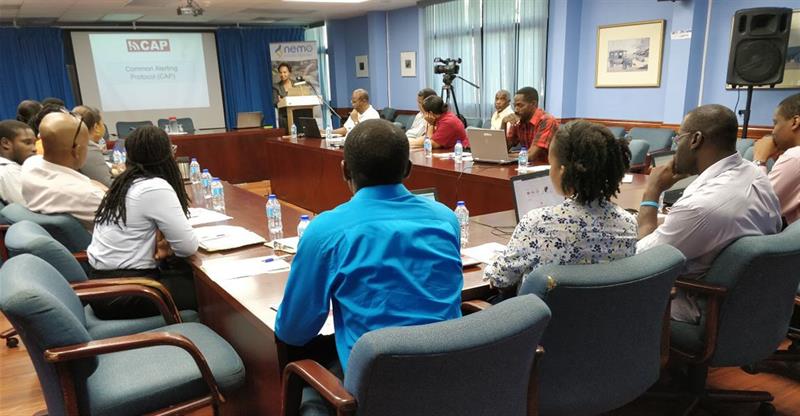THE COMMON ALERTING PROTOCOL IS AN INTERNATIONALLY-ACCEPTED DIGITAL FORMAT FOR DISSEMINATING SIMULTANEOUS EMERGENCY ALERTS.
 The National Emergency Management Organization (NEMO), teamed up with the Saint Lucia Meteorology Services and other stakeholders, for a two-day Jump Start Training Workshop on the Common Alerting Protocol (CAP), an internationally-accepted digital format for disseminating simultaneous emergency alerts.
The National Emergency Management Organization (NEMO), teamed up with the Saint Lucia Meteorology Services and other stakeholders, for a two-day Jump Start Training Workshop on the Common Alerting Protocol (CAP), an internationally-accepted digital format for disseminating simultaneous emergency alerts.
NEMO Director Velda Joseph said the training exercise provided a platform for critical thinking, knowledge exchange, and practical application.
“At the NEMO Secretariat, we have this vision to have a national early warning system platform, but we can’t do it through our own independent efforts. As such, it is necessary to have this collaborative arrangement to make sure that it is successful and to make sure that we are serving the population of Saint Lucia,” she said.
“We all understand that the way to go is to find ways of reducing risks and what better way to do that than to warn people in advance, so that they can take the appropriate action. We all understand that multi-hazard warning systems save lives, and that science, technology, and innovation offer us greater opportunities for understanding what is happening around us.”
An early warning refers to the provision of information on an emerging emergency system. Currently, NEMO is able to use a few early warning mechanisms such as the radio broadcast interrupt.
Workshop facilitator Eliot Christian, Consultant to the World Metrological Organization and specialist on the Common Alerting Protocol explained how the CAP works.
“Traditionally, what we have been doing is sending alerts with full texts, that is not very easy to process with machines. So for example if you have an alert for a particular area, the text description of the area is not very useful compared to an actual polygon. Because with a polygon your car can actually tell you turn right because there is a tsunami coming ashore. When we put the data together with the information, that is what CAP is all about. The Red Cross and non-governmental organizations can be involved, and it’s available in any language so that it can reach as many people as possible, even those who are physically impaired.”
The Jump Start Training Workshop on the Common Alerting Protocol, was funded by the Canadian Government through the World Bank and World Meteorology Organization. It was held on March 1 and 2, at the Ministry of Infrastructure.